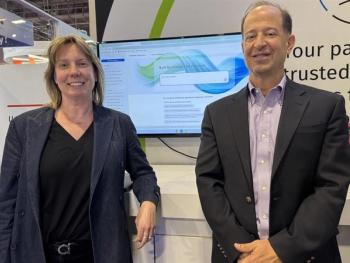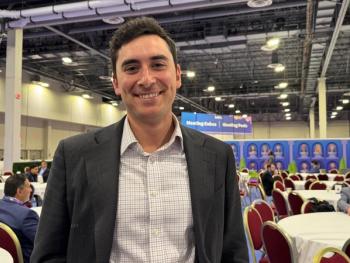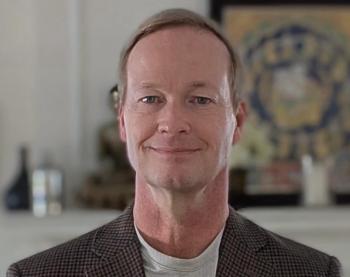
PX: New Roles for Amazon, Blockchain, PBMs and Preventive Care in Health Tech
Technology and medicine aren't just crossing paths, they're converging. What does a happy medium look like?
The digital transformation is ushering in fundamental change throughout healthcare. Old health system staples will inevitably be forced to change, if they're not forced out entirely. But nature abhors a vacuum, so new players will inevitably find a way in to replace them, for better or worse.
Who are these players? What do they look like now, and how should they evolve in order to best serve the patient? Are there substantial savings to be had in the short term, or is it time to whip out the checkbook and work towards long term ROI?
New Roles for Amazon, Blockchain, PBMs and Preventive Care in Health Tech
A Healthcare Analytics News® Peer Exchange®
Segment 9/13
Kevin R. Campbell, MD: Let me focus and home in on this. I know we talked about the big guys, and now we talked about the little guys. Let’s talk about Amazon, as we have been talking about, but let’s dive a little deeper because I really want to see what you guys think. How is Amazon going to affect CVS, Walgreens, the Walmart pharmacies, and the Kroger pharmacies of the world? How is it going to make an impact and is it good or is it bad? You’re our economist, so it has to go to you.
Jane Sarasohn-Kahn, MA, MHSA: It’s about supply chain first, as Colin alluded to earlier, and Walmart has been very good at this as well, so I’ll bring that up again. I’ve got no skin in that game, by the way. They’re not paying me to say that. But we look at, How do we in the value chain of healthcare — this is how we economists talk — take costs out at every turn? It’s not just every cost for everything, but now we think about this lofty goal, this beacon we have in healthcare called the Quadruple Aim. It used to be the Triple Aim, but now we’re talking about our clinicians. We want to drive outcomes, we want to enhance or enchant the experience, we want to reduce per capita costs — that’s the one I’m going to come back to — or per patient cost, and we want to boost our clinicians because if we have burned out doctors and nurses, we can’t do any of this. We really want our labor force to be resilient, and that’s what this fourth leg in the Quadruple Aim is about, in addition to the Triple Aim.
In the Quadruple Aim or the Triple Aim, when other people talk about reducing costs, they forget that when the IHI [Institute of Healthcare Improvement] came up with that with Dr. Donald Berwick, it was reducing cost per patient, per capita. So, if you have a very sick patient and you just move the needle on that patient who’s going to be high cost, it’s still a beautiful thing. You don’t just slash and burn cost. If Amazon is careful now, we’ll bring it full circle, to innovate in the supply chain at every point with PillPack, with Whole Foods, and with Food as Medicine. They can bring their Blue Apron-style medical food to the patient, delivered to the home, because they have the data on the patient. With their cheap OTCs [over-the-counter] and low cost, they can start to innovate the supply chain.
Kevin R. Campbell, MD: My biggest concern with this is that we make sure the Amazons of the world keep the PBMs, or pharmacy benefit managers, out of it. Those are the Tony Sopranos of the drug industry, the PBMs.
John Nosta, BA: Think about the analogy to blockchain. I’m surprised no one has mentioned blockchain yet.
Kevin R. Campbell, MD: We waited for you.
John Nosta, BA: We have to. I don’t even know what it is, but all I’ll tell you is that it sounds interesting to me. But blockchain gets rid of the middle man. Blockchain allows for that connection between two stakeholders, and I think there’s an analogy here in what’s happening with Amazon. Think about Amazon and Whole Foods. Well, that was disruptive and a bit problematic, but I think when you get the PBMs out of the game you have a direct connection, which is market access, which is profound. There’s a parallel theme to that.
Kevin R. Campbell, MD: I know you know, but for our audience, the PBMs are taking money from both sides. That’s why I called them Tony Soprano. They’re taking money from the maker of the drug and then they’re taking money from the institution that’s delivering the drug. They’re getting paid on both sides, so they really don’t care. They just line their pockets at the expense of our patients.
John Nosta, BA: And when we talk about drug pricing and increasing cost of goods, we always shine the light on pharmaceuticals, but we don’t shine the light on the intermediary path, which really constitutes great cost.
Jane Sarasohn-Kahn, MA, MHSA: They’re so opaque, that’s why. There’s no transparency.
Geeta Nayyar, MD, MBA: And Amazon is going to put the pressure on Walmart; it is going to put the pressure on Publix. I think it’s going to help the industry across the grid. But one of the other big costs —Jane, you know this as the economist—is end-of-life care. We haven’t said anything about the acute care setting, the pharmaceutical costs in an acute care setting. I don’t know how much of this is really going to translate into that piece because we know that is also one of the biggest burdens from a price standpoint.
John Nosta, BA: Ultimately, the value of technology is in preventive medicine. We look at all the dollars at the end of life that are being spent, and we always say prevent, prevent, prevent. Eat your spinach, exercise, and get your butt off the couch. That’s nonsense. That really doesn’t work. What we will find is that nanomediated, early detection of cancer — nanoparticle-mediated detection — will get at an early diagnosis that actually shares a border with prevention. The way to get to prevention is not getting your butt out on the track, but using technology. I think we’ll find very, very interesting opportunities to deliver technology there and save costs.
Colin Hung, BaSC: I think what’s exciting for me, whether it’s Walmart or it’s CVS or even Walgreens, is this merger of—Jane, you mentioned it—diet, nutrition, and shopping habits along with your diagnosis. So, if I know you have a certain condition, why not adjust the price of the healthy food a little bit down to encourage that person to adopt that? Instead of that Blue Apron approach, we can say, “Hey, we know the medications you’re on, and we know that this set of food goes well with that or it can help you with that.” To me, now that Amazon has gotten into the business of also being a payer, there’s an incentive to say, “You know what, we want to keep you healthy. I’m willing to take a cut on this margin over here because down the road, I’m going to make that back.”
John Nosta, BA: Do you think we’re having a fundamental shift into retail medicine?
Geeta Nayyar, MD, MBA: Oh, no doubt.
John Nosta, BA: The role of the doctor, the personal doctor, may be that I’ll get my EKG [electrocardiogram] taken at the airport while I’m waiting for a plane.
Geeta Nayyar, MD, MBA: I think the role of the doctor is changing. It’s about Dr. Mom, and Dr. Mom shops at CVS, Walmart, and Amazon. When anyone in the household gets sick, the first person they call is mom and then the second decision is made by mom: whether you go to the doctor, whether you go to CVS. It’s definitely about the consumer.
Kevin R. Campbell, MD: I think from a global standpoint here in the United States, when we had the Affordable Care Act come down the pipe eight or ten years ago, it was all about changing the focus of America from treatment of disease to prevention of disease. That has not happened, and it’s my hope, just as John alluded to, that technology and disruption can change our focus from treatment to prevention.
Jane Sarasohn-Kahn, MA, MHSA: Here’s what technology can’t do. I’ve got to stand up for the social determinants of health at the table.
John Nosta, BA: I disagree.
Jane Sarasohn-Kahn, MA, MHSA: It’s what technology can’t do, but technology can help us bring social determinants to people’s homes through Lyft and Uber, through Amazon Prime, or through subscriptions for SNAP [Supplemental Nutrition Assistance Program] enrollees who can get fresh food delivered to their home if they have food stamp benefits. But if we don’t bake in public policy health into transportation policy, food policy, or urban planning policy and clean air — I’m from Michigan, what’s going on in Flint is very dear to me — kids are going to die younger and have learning difficulties as they age if they were drinking this water as babies. What we need to do is also be mindful that we live in an ecosystem, and I use that word purposefully, where we need public policy makers, at Washington and state level, to also think about health everywhere. If we did that, we’d be spending less money downstream on illness and have more quality of life at the end of life. I have to just call that out.
Geeta Nayyar, MD, MBA: Jane, I’m going to send you a postcard.
Jane Sarasohn-Kahn, MA, MHSA: Please do. I’m going to love it.
Colin Hung, BaSC: But I think this is where it’s key. That’s why I’m encouraged by Apple and other folks because they have mastered something that these traditional companies in medicine have not, which is nudging the behavior of individuals. Apple, Netflix, and Amazon are nudging us towards streaming rather than watching traditional television. They’ve been able to do that, and I think merging what they know about us as individuals, as consumers, is going to be very exciting to help us change our behavior around these social determinants of health.
Jane Sarasohn-Kahn, MA, MHSA: Behavioral economics will help nudge us because Netflix is cheaper than going to the movies, or a MoviePass is even cheaper now.
Get the best insights in healthcare analytics








































